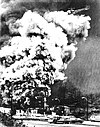 Postcard painting of the Mather Mine in Mather, Morgan Township, Pennsylvania. | |
| Date | May 19, 1928 |
|---|---|
| Time | 4:07 PM |
| Location | Mather, Pennsylvania |
| Coordinates | 39°56′05″N80°04′25″W / 39.9348°N 80.0737°W |
| Cause | Gas and dust explosion |
| Casualties | |
| 195 dead | |
The Mather Mine disaster refers to the events surrounding an explosion that occurred in the Mather Mine on May 19, 1928, at 4:07 PM in Mather, Pennsylvania. A report released by the United States Bureau of Mines states that a total of 195 men were killed in the catastrophe, of which two died in hospitals after being discovered by rescue crews and volunteers. [1] [2] The Mather Mine disaster ranks as the seventh worst mining disaster in U.S. history and the second worst in Pennsylvania history.
